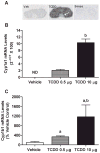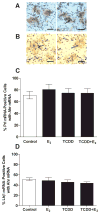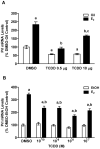Aryl hydrocarbon receptor activation in lactotropes and gonadotropes interferes with estradiol-dependent and -independent preprolactin, glycoprotein alpha and luteinizing hormone beta gene expression
- PMID: 21187122
- PMCID: PMC3059512
- DOI: 10.1016/j.mce.2010.12.027
Aryl hydrocarbon receptor activation in lactotropes and gonadotropes interferes with estradiol-dependent and -independent preprolactin, glycoprotein alpha and luteinizing hormone beta gene expression
Abstract
Arylhydrocarbon receptor (Ahr) activation by 2,3,7,8-tetrachlordibenzo-p-dioxin (TCDD) interferes with female reproductive functions, but there is little information on the specific targets of TCDD in the hypothalamic-pituitary-gonadal (HPG) axis. In these studies, we found that TCDD upregulated known AhR target genes, cytochrome p450 1a1 (Cyp1a1), Cyp1a2 and Cyp1b1 in the rat pituitary gland. Moreover, 75% of pituitary lactotropes and 45% of gonadotropes contained Ahr mRNA, and most Ahr-containing cells were estrogen receptor 1 (Esr1)-positive. TCDD abrogated estradiol (E(2))-induced prolactin (Prl) expression in vivo and in vitro; conversely, E(2) blocked TCDD upregulation of luteinizing hormone beta (Lhb) and glycoprotein hormone alpha polypeptide (Cga) expression. TCDD had no effect on levels of Ahr mRNA, but upregulated Esr1 mRNA. E(2) independently repressed Ahr and Esr1 expression and blocked TCDD upregulation of Esr1. Thus, complex interactions between Ahr and Esr alter Prl and luteinizing hormone (LH) synthesis by direct actions in lactotropes and gonadotropes. These findings provide important insights into how TCDD disrupts female reproductive functions.
Copyright © 2010 Elsevier Ireland Ltd. All rights reserved.
Figures







References
-
- Augustine RA, Kokay IC, Andrews ZB, Ladyman SR, Grattan DR. Quantitation of prolactin receptor mRNA in the maternal rat brain during pregnancy and lactation. J Mol Endocrinol. 2003;31:221–232. - PubMed
-
- Beischlag TV, Perdew GH. ER alpha-AHR-ARNT protein-protein interactions mediate estradiol-dependent transrepression of dioxin-inducible gene transcription. J Biol Chem. 2005;280:21607–21611. - PubMed
-
- Bestervelt LL, Pitt JA, Piper WN. Evidence for Ah receptor mediation of increased ACTH concentrations in primary cultures of rat anterior pituitary cells exposed to TCDD. Toxicol Sci. 1998;46:294–299. - PubMed
Publication types
MeSH terms
Substances
Grants and funding
LinkOut - more resources
Full Text Sources
Molecular Biology Databases
Research Materials
Miscellaneous

